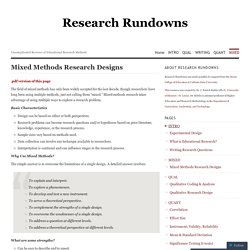

The four main approaches - Types of research - Understanding dementia research - Research - Alzheimer Europe. Quantitative research Quantitative research is generally associated with the positivist/postpositivist paradigm.

It usually involves collecting and converting data into numerical form so that statistical calculations can be made and conclusions drawn. The process Researchers will have one or more hypotheses. These are the questions that they want to address which include predictions about possible relationships between the things they want to investigate (variables). Data is collected by various means following a strict procedure and prepared for statistical analysis. The results of statistical analyses are presented in journals in a standard way, the end result being a P value. Principles Objectivity is very important in quantitative research. Researchers go to great lengths to ensure that they are really measuring what they claim to be measuring. External factors, which might affect the results, must also be controlled for. When looking at results, the P value is important. Principles. Multimethodology.
Multimethodology or multimethod research includes the use of more than one method of data collection or research in a research study or set of related studies.

Mixed methods research is more specific in that it includes the mixing of qualitative and quantitative data, methods, methodologies, and/or paradigms in a research study or set of related studies. One could argue that mixed methods research is a special case of multimethod research. Another applicable, but less often used label, for multi or mixed research is methodological pluralism. All of these approaches to professional and academic research emphasize that monomethod research can be improved through the use of multiple data, methods, methodologies, perspectives, standpoints, and paradigms.[1] The term 'multimethodology' was used starting in the 1980s and in the 1989 book Multimethod Research: A Synthesis of Styles by John Brewer and Albert Hunter (Sage Publications). Mixed Methods Research Designs.
.pdf version of this page The field of mixed methods has only been widely accepted for the last decade, though researchers have long been using multiple methods, just not calling them “mixed.”

Mixed methods research takes advantage of using multiple ways to explore a research problem. Basic Characteristics Design can be based on either or both perspectives.Research problems can become research questions and/or hypotheses based on prior literature, knowledge, experience, or the research process.Sample sizes vary based on methods used.Data collection can involve any technique available to researchers.Interpretation is continual and can influence stages in the research process.
Why Use Mixed Methods? The simple answer is to overcome the limitations of a single design. What are some strengths? What are some weaknesses? Methodologist John Creswell suggested a systematic framework for approaching mixed methods research. Four Decisions for Mixed Method Designs (Creswell, 2003, p. 211) 1. 2. 3. 4. The four main approaches - Types of research - Understanding dementia research - Research - Alzheimer Europe. Design-based research. Design-based research (DBR) is a type of research methodology commonly used by researchers in the learning sciences.

Within design-based research methodology, interventions are conceptualized and then implemented iteratively in natural settings in order to test the ecological validity of dominant theory and to generate new theories and frameworks for conceptualizing learning, instruction, design processes, and educational reform. Data analysis often takes the form of retrospective, cross-iteration comparisons. Role of design-based research within the learning sciences[edit] Methodologically, the learning sciences is distinguished from other fields that study learning in humans in its methodological treatment of the subjects of its study, learners, their localities, and their communities.
History and controversy[edit] Design research. Design research was originally constituted as primarily research into the process of design, developing from work in design methods, but the concept has been expanded to include research embedded within the process of design, including work concerned with the context of designing and research-based design practice.

The concept retains a sense of generality, aimed at understanding and improving design processes and practices quite broadly, rather than developing domain-specific knowledge within any professional field of design. Origins[edit] Design Research emerged as a recognisable field of study in the 1960s, initially marked by a conference on Design methods[1] at Imperial College London, in 1962. It led to the founding of the Design Research Society (DRS) in 1966. John Christopher Jones (one of the initiators of the 1962 conference) founded a postgraduate Design Research Laboratory at the University of Manchester Institute of Science and Technology, and L. Early work[edit] Complete Beginner's Guide to Design Research. In an industry devoted to the people who use our products, services, and applications, research is paramount.

We ask questions. We take notes. We learn everything we can about the target audience, and then iteratively test our work throughout the design process. Want UX Tips Delivered Straight to Your Inbox? Original UX articles Curated Resources Never miss an issue!